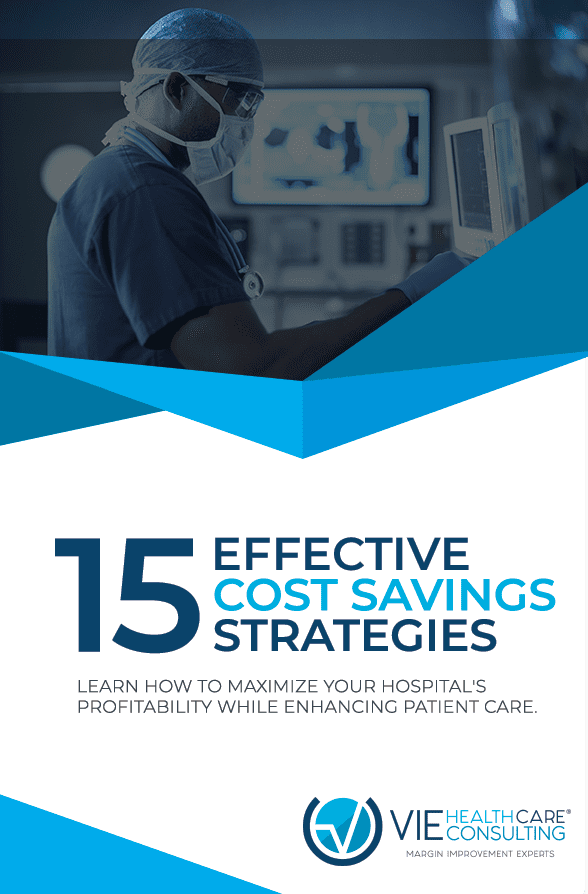Innovative Strategies To Improve Margins
This article was written by Lisa Miller.
The financial pressure on hospitals continues unabated, forcing healthcare organizations to seek out more innovative hospital cost savings strategies.
At the beginning of 2019, it was predicted that, as margins continue to deteriorate in healthcare, the ‘hospitals that manage their costs the best will be the most successful.[1]’ At the time of writing, 14 hospitals have closed so far this year. That number is expected to rise. [2]
The most successful hospitals are those which manage their costs most effectively. Click To Tweet
For healthcare leaders who feel they have exhausted their options, the challenge is to uncover cost savings in areas you may have overlooked.
Based on my experience as CEO of VIE Healthcare Consulting, I’ve addressed four innovative hospital cost saving strategies below. Our expertise has already saved healthcare systems throughout the US over $600 million with the implementation of proven hospital cost savings strategies.
#1 Direct Contracting With Your Vendors (Don’t Rely Exclusively on Your GPOs For Contracting)
Negotiating cost-effective supply agreements with multiple vendors is a challenge for hospitals who rely on GPOs to achieve the best possible price for their medical supplies and equipment. But we are witnessing something of a shift. Concerns over kickbacks and monopolization have given rise to additional concerns over just how cost effective GPOs really are.
Today, innovative healthcare leaders are implementing successful hospital cost savings strategies in a move towards bypassing GPOs and ‘owning and controlling their own supply chain destinies.’
One of the biggest barriers to direct contracting is a lack of experience in vendor negotiation. The prospect of facing a skilled team of representatives from your vendor can be daunting for most healthcare employees and often leads to much higher costs for medical supplies.
At VIE Healthcare, we provide dedicated negotiation skills training and help you to build an in-house team to strengthen your position and drive margin improvement.
#2 Analyze Usage Data for Variation and Spend Outliers

Analyzing usage data for your organization enables you to reduce your utilization expenditure and realize major cost savings. Not every organization is willing to carry out a deep dive into that data, despite the potential hospital cost savings available. It is a strategy we recommend to all of our clients.
The same principles apply to outliers, where costs exceed the predicted amount for a specific surgery or treatment. All healthcare organizations have them, and they offer significant but often overlooked potential for your hospital’s cost savings strategy. Outliers typically include inventory issues, clinical variations, bilateral surgery and waste reporting.
As a starting point, I suggest a 12 month AP vendor spend report analyzed on a month by month basis to identify potential areas of overspend.
#3 Analyze Line Item Purchased Services Data
Analyzing the line item details in your purchased services spend is one of the most effective cost savings strategies that your hospital can implement.
Purchased services can account for between 40-50% of your non-labor costs, yet in some cases, healthcare leaders lack vital visibility into this key area of hospital cost savings. For example:
- In some organizations, it is possible for departments to have different contracts with the same vendor at significantly varying rates.
- Some contracts continue to operate on an annual renewal which takes place automatically, without a review. If this applies to your hospital, it is likely that you are unaware of how much those agreements are impacting your bottom line.
- Price fluctuations can be missed.
- In some cases 30% of hospital purchased services spend is either not detailed on the contract or does not match the agreed pricing.
Our proven, automated process, Invoice ROI™ enables your hospital to track these costs in real time and compare them to historical data to deliver actionable intelligence.
We begin our in-depth process by carrying out an essential line item analysis and reconciliation before taking a deep dive into the past 12-18 months of your invoicing data before moving to benchmarking.
Our proven, automated Invoice ROI™ process guarantees margin improvement in your hospital’s purchased services spend. Click To Tweet
This unparalled approach offers an essential hospital cost savings strategy for every health system.
#4 Be Willing to Review “Sensitive” Vendor Costs

Healthcare organizations can sometimes be hesitant in analyzing the costs related to more ‘sensitive’ vendors in areas such as marketing, legal and finance. Yet, analysis of these key areas of spend can reveal significant potential hospital cost savings.
For example:
Legal costs: Hospitals can often incur significant legal costs without understanding exactly what services they are paying for. We recommend carrying out a comprehensive analysis to clarify potential issues relating to your hourly rate and identify additional fees. Legal invoices can often contain incorrect and inconsistent charges, for example.
Financial fees: An in-depth evaluation of bank fees and merchant cards can reveal an untapped source of cost savings for your hospital. I recommend a monthly analysis and renegotiation on a minimum quarterly basis. In my experience, this one simple cost savings strategy can potentially save your hospital hundreds of thousands of dollars.
Likewise, many healthcare organizations are often unaware of the total costs charged for debit and credit card payments. Many of these services carry additional fees in areas relating to process, card vendors and payment gateways.
While they can be difficult to understand, it is essential for your hospital to be aware that these costs are negotiable.
Delivering margin improvement requires the creation of a robust cost improvement culture.
VIE Healthcare delivers a fully customized hospital cost-savings approach to help your organization achieve that goal.
[1] https://www.healthcarefinancenews.com/news/7-supply-chain-predictions-healthcare-2019
[2] https://knowledge.wharton.upenn.edu/article/us-hospitals-closing-hahnemann/



